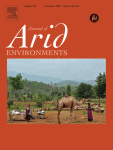Ver ítem
- xmlui.general.dspace_homeCentros Regionales y EEAsCentro Regional Patagonia SurEEA EsquelArtículos científicosxmlui.ArtifactBrowser.ItemViewer.trail
- Inicio
- Centros Regionales y EEAs
- Centro Regional Patagonia Sur
- EEA Esquel
- Artículos científicos
- Ver ítem
How does grazing affect soil water availability in the Patagonian steppe?
Resumen
In the Patagonian steppe, grazing may or may not reduce soil water availability: it may increase evaporative losses, because it reduces plant cover, but may decrease transpiration losses because it decreases plant biomass. Therefore, grazing could reduce soil water availability in the superficial layer, mostly affected by evaporation, but could increase it in the subsurface layers, mostly affected by transpiration. Our hypothesis is that such effects
[ver mas...]
In the Patagonian steppe, grazing may or may not reduce soil water availability: it may increase evaporative losses, because it reduces plant cover, but may decrease transpiration losses because it decreases plant biomass. Therefore, grazing could reduce soil water availability in the superficial layer, mostly affected by evaporation, but could increase it in the subsurface layers, mostly affected by transpiration. Our hypothesis is that such effects would be most evident in the bare soil spaces, with higher evaporative losses and lower root density than vegetated microsites. Therefore, we analyzed the proportion of four microsites (shrubs, bare soil, preferred- and unpreferred grasses), and their soil water availability at 0–5 and 5–15 cm depth in four sampling areas, each one with an ungrazed, a moderately- and an intensely-grazed site. Our results supported the initial hypothesis: bare soil microsites had the lowest surface, but the highest subsurface water availability. However, grazing did not cause any change in the mean soil water availability (net effect) because it did not affect soil water availability in any microsite and depth (direct effects), and only caused a replacement of preferred-by unpreferred grasses (indirect effects), two groups that induced small differences in water availability.
[Cerrar]

Autor
Golluscio, Rodolfo Ángel;
Garcia Martinez, Guillermo Carlos;
Cavagnaro, Fernando Pablo;
Fuente
Journal of Arid Environments 205 : 104800. (October 2022)
Fecha
2022-06-01
Editorial
Elsevier
ISSN
0140-1963
Formato
pdf
Tipo de documento
artículo
Palabras Claves
Derechos de acceso
Restringido
 Excepto donde se diga explicitamente, este item se publica bajo la siguiente descripción: Creative Commons Attribution-NonCommercial-ShareAlike 2.5 Unported (CC BY-NC-SA 2.5)
Excepto donde se diga explicitamente, este item se publica bajo la siguiente descripción: Creative Commons Attribution-NonCommercial-ShareAlike 2.5 Unported (CC BY-NC-SA 2.5)

